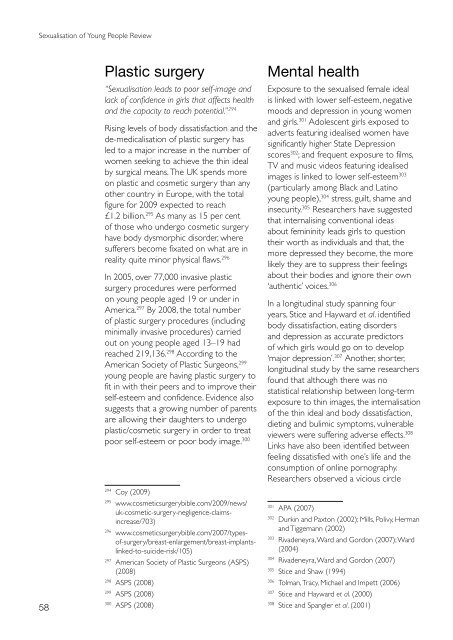Sexualistation of Young People
Sexualistation of Young People
Sexualistation of Young People
You also want an ePaper? Increase the reach of your titles
YUMPU automatically turns print PDFs into web optimized ePapers that Google loves.
Sexualisation <strong>of</strong> <strong>Young</strong> <strong>People</strong> Review<br />
58<br />
Plastic surgery<br />
“Sexualisation leads to poor self-image and<br />
lack <strong>of</strong> confidence in girls that affects health<br />
and the capacity to reach potential.” 294<br />
Rising levels <strong>of</strong> body dissatisfaction and the<br />
de-medicalisation <strong>of</strong> plastic surgery has<br />
led to a major increase in the number <strong>of</strong><br />
women seeking to achieve the thin ideal<br />
by surgical means. The UK spends more<br />
on plastic and cosmetic surgery than any<br />
other country in Europe, with the total<br />
figure for 2009 expected to reach<br />
£1.2 billion. 295 As many as 15 per cent<br />
<strong>of</strong> those who undergo cosmetic surgery<br />
have body dysmorphic disorder, where<br />
sufferers become fixated on what are in<br />
reality quite minor physical flaws. 296<br />
In 2005, over 77,000 invasive plastic<br />
surgery procedures were performed<br />
on young people aged 19 or under in<br />
America. 297 By 2008, the total number<br />
<strong>of</strong> plastic surgery procedures (including<br />
minimally invasive procedures) carried<br />
out on young people aged 13–19 had<br />
reached 219,136. 298 According to the<br />
American Society <strong>of</strong> Plastic Surgeons, 299<br />
young people are having plastic surgery to<br />
fit in with their peers and to improve their<br />
self-esteem and confidence. Evidence also<br />
suggests that a growing number <strong>of</strong> parents<br />
are allowing their daughters to undergo<br />
plastic/cosmetic surgery in order to treat<br />
poor self-esteem or poor body image. 300<br />
294 Coy (2009)<br />
295 www.cosmeticsurgerybible.com/2009/news/<br />
uk-cosmetic-surgery-negligence-claimsincrease/703)<br />
296 www.cosmeticsurgerybible.com/2007/types<strong>of</strong>-surgery/breast-enlargement/breast-implantslinked-to-suicide-risk/105)<br />
297 American Society <strong>of</strong> Plastic Surgeons (ASPS)<br />
(2008)<br />
298 ASPS (2008)<br />
299 ASPS (2008)<br />
300 ASPS (2008)<br />
Mental health<br />
Exposure to the sexualised female ideal<br />
is linked with lower self-esteem, negative<br />
moods and depression in young women<br />
and girls. 301 Adolescent girls exposed to<br />
adverts featuring idealised women have<br />
significantly higher State Depression<br />
scores 302 ; and frequent exposure to films,<br />
TV and music videos featuring idealised<br />
images is linked to lower self-esteem 303<br />
(particularly among Black and Latino<br />
young people), 304 stress, guilt, shame and<br />
insecurity. 305 Researchers have suggested<br />
that internalising conventional ideas<br />
about femininity leads girls to question<br />
their worth as individuals and that, the<br />
more depressed they become, the more<br />
likely they are to suppress their feelings<br />
about their bodies and ignore their own<br />
‘authentic’ voices. 306<br />
In a longitudinal study spanning four<br />
years, Stice and Hayward et al. identified<br />
body dissatisfaction, eating disorders<br />
and depression as accurate predictors<br />
<strong>of</strong> which girls would go on to develop<br />
‘major depression’. 307 Another, shorter,<br />
longitudinal study by the same researchers<br />
found that although there was no<br />
statistical relationship between long-term<br />
exposure to thin images, the internalisation<br />
<strong>of</strong> the thin ideal and body dissatisfaction,<br />
dieting and bulimic symptoms, vulnerable<br />
viewers were suffering adverse effects. 308<br />
Links have also been identified between<br />
feeling dissatisfied with one’s life and the<br />
consumption <strong>of</strong> online pornography.<br />
Researchers observed a vicious circle<br />
301 APA (2007)<br />
302 Durkin and Paxton (2002); Mills, Polivy, Herman<br />
and Tiggemann (2002)<br />
303 Rivadeneyra, Ward and Gordon (2007); Ward<br />
(2004)<br />
304 Rivadeneyra, Ward and Gordon (2007)<br />
305 Stice and Shaw (1994)<br />
306 Tolman, Tracy, Michael and Impett (2006)<br />
307 Stice and Hayward et al. (2000)<br />
308 Stice and Spangler et al. (2001)

















